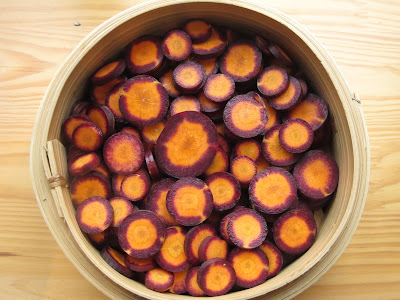Again, I have been away for a while and I won’t make any excuses...
But I would like to say, my lovely followers, that I will be less regular here,
as a new business I am putting together is taking more and more of the time I
would like to dedicate to my blog. However, I will keep posting delicious and
nutritious recipes here whenever I can. Keep checking it out, please!
As for this week, aubergines are at the top of my list of most
delicious vegetables. I could eat a meal made with aubergines every day. My
favourite way of cooking them is grilling or roasting. Here is my twist on Nigel
Slater’s grilled aubergine with a garlic cream.
 |
| Roasted garlic cloves wrapped in foil |
 |
| Garlicky cream |
 |
| Once the aubergines are cool enough to handle peel away the skin |
 |
| Brush the aubergines with some more coconut oil, season and return to the grill |
 |
| Serve them with a dollop of the garlicky cream and some of the whole roasted garlic |
Grilled aubergine and
garlicky cream
Serves 2
An extremely tasty, balanced and healthy dish. Garlic and aubergine are one of the best marriages.
INGREDIENTS
1 whole bulb of garlic
1 whole bulb of garlic
Olive oil
2 sprigs of
thyme
6 tablespoon
of sheep’s yoghurt
A juice of 1
lime
1 tsp capers
A handful of
basil
2 large
aubergines
1 Tbsp
coconut oil or olive oil
METHOD
Set the oven
at 200C. Pour a bit of olive oil over the garlic bulb, sprinkle it with the
thyme sprigs and wrap the bulb in foil. Roast for about 50 minutes.
Remove from
the oven, unwrap and set aside.
When the
garlic is cool enough to handle, squeeze the cloves until they come out of
their skin. Stir into the yoghurt and bring into a paste. Squeeze the lime
juice into a bowl and mix well. Add the basil leaves and capers.
Melt the
coconut oil. Score the skin of aubergines, cutting from the stalk to the base.
Lightly oil the aubergines and grill, turning constantly until the flesh is
soft and the skin is almost burnt.
Once they
are cool enough to handle, peel away the skin and split the aubergine in two
halves. Brush with some more coconut oil, season and return to the grill.
Serve with a
dollop of the garlicky cream and some of the whole roasted garlic. Yum!
Some of the ingredients and their healthy
benefits
Aubergine or
Eggplant (Solanum melongena): It is a
great source of bioflavonoids. It has antioxidant properties due to a compound
(nasunin), that can prevent the formation of free radicals and protect against
cell damage. Aubergine eliminates excess iron in the blood. It contains a good
amount of vitamin C, B vitamins, copper (for protection of the cardiovascular,
skeletal, and nervous systems), magnesium (nature’s natural relaxant),
manganese (very beneficial for a good digestion), phosphorus (important for
proper kidney function and needed for healthy bones, teeth, muscles and
nerves); and potassium (for proper nerve and muscle functions). Aubergine plays
an important role in lowering blood cholesterol.
Caution: Aubergine contains a naturally-occurring substance found in plants
called oxalates. Oxalates can become too concentrated in body fluids and
crystallize, causing some health problems. People with kidney and gallbladder
conditions should avoid eating this vegetable.
Garlic (Allium sativum): is one of nature’s first known
medicines. It helps to prevent the common cold due to its antiviral properties. Garlic is packed with antioxidants and contains antibacterial properties. Some studies have shown that garlic can help to lower blood pressure and cholesterol.
Sheep’s yoghurt: For some people,
sheep yoghurt is easier to digest than yoghurt made from cow’s milk. It boosts
immunity and is very helpful in cases of stomach ulcers. It is high in
protein, natural fats, calcium, magnesium and zinc. It is a natural source of
probiotic activity (live friendly bacteria) that enriches the intestinal
flora, maintaining a good digestive system. It also contains three times more
whey protein than yoghurt made from cow’s milk.
Till soon!























































